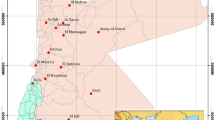Abstract
El Shalal-Kema area is located east of Aswan town and Nile River. The Quaternary sediments (unconsolidated material of sands, gravels, and clays intercalation) represent the main aquifer in the studied area. Its water is under unconfined condition, and the water table is shallow (vary from 7.5 to 16.3 m). The concerned aquifer is recharged mainly from Aswan Dam Lake, from the excess irrigation water and from septic tanks, where the area is not served by sewage system. The direction of the groundwater movement is generally from south to north. The transmissivity values of the Quaternary aquifer (from three pumping tests) are relatively high (vary from 1,996 to 3,029 m2/day). The exploitation of groundwater is carried out where there is continuous withdrawal for industrial and domestic uses with a total average quantity of groundwater of 71,304 m3 per day (25.67 million m3 per year). The hydrochemical characteristics of the Quaternary aquifer is studied based on the chemical analysis of 29 groundwater and four surface water samples collected from different sites. The chemical composition of the groundwater is dominated by calcium Ca2+ from the cations and bicarbonate (HCO −3 ) from the anions, and the order of cation abundance is Ca2+ > Na+ > Mg2+ > K+ and HCO −3 > SO 2−4 > Cl− among the anions. The groundwater types are normal chloride water, normal sulfate water, and normal carbonate water. The hypothetical salt combination revealed the presence of different salts arranged in terms of their predominant as Ca(HCO3)2, Mg(HCO3)2, NaCl, Na2SO4, MgSO4, KCL, NaHCO3, MgCl2, CaSO4, and K2SO4. The analytical measurements to the NO2 and NH3 reveal that their values decrease in summer and increase in winter due to the stoppage of pumping which leads to the increase of the wastewater quantities that reach the groundwater. The chemical and microbiological analyses show that the aquifer in this area is contaminated with fecal and disease-causing bacteria. The main cause of this contamination is the outflow from the septic tanks; therefore, the construction of sewage network is a vital solution. Chlorination is important to disinfect the groundwater at the tanks before its distribution to the houses.



















Similar content being viewed by others
References
Attia ML (1954) Deposits in the Nile Valley and the delta. Geol Suv Egypt, Cairo, 356p
Barber W, Carr DP (1981) Water management capabilities of the alluvial aquifer system of the Nile Valley, Upper Egypt. Technical Report No. 11, Water Master Plan, Ministry of Irrigation, Cairo, Egypt
Davies-Colley RJ, Smith DG (2001) Turbidity, suspended sediment, and water clarity—a review. J Am Water Resour Assoc 37(5):1085–1101
Essington M (2004) Soil and water chemistry: an integrative approach. CRC Press, New York, pp 255–308, Ch. 6, Mineral Solubility
Fetter CW (1980) Applied hydrogeology. Charles E. Merrill, Columbus, Ohio, 488p
Freez RA, Cherry 3A (1979) Groundwater. Prentice Hall Inc., Englewood Cliffs, N.J., 601p
Gamage VS, Hodge VF, Cizdziel JV, Kazumasa L (2010) Determination of vanadium (IV) and (V) in Southern Nevada groundwater by ion chromatography-inductively coupled plasma mass spectrometry. Open Chem Biomed Meth J 3:10–17
Gheorhge A (1978) Processing and synthesis of hydrogeological data. Abacus, Tunbridge Wells, 390p
ASTM International (2003) D1889-00 Standard test method for turbidity of water, in ASTM International, Annual Book of ASTM Standards, Water and Environmental Technology, 2003, v. 11.01, West Conshohocken, Pennsylvania, 6p
Issawi B, Jux U (1982) Contribution to the stratigraphy of the Paleozoic rocks in Egypt. Geol Surv Egypt, Cairo, V 64, p. 1–28
Karanjac J, Braticevic D (1994) Ground-Water software for Windows (GWW). United Nation, Department for Development Support and Management Services, New York
Ovchinnikov AM (1955) General hydrogeology. Moscow, USSR
Piper AM (1944) A graphic procedure in the geochemical interpretation of water analysis. Trans Am Geophy Union, 25, 6, Washington, D. C., pp. 914–928
Richards A (1954) Diagnosis and improvement of saline and alkali soils. U.S.D.A. Handbook No.6
RIGW (1988) Hydrogeological map of Egypt. First Edition, Cairo
Said R (1962) The Geology of Egypt. Elsevier Pub. Co., Amsterdam, New York, p 337
Said R (1981) The geological evolution of the River Nile. Springer. New York Inc., 151p
Schoeller H (1956) Gèochimie des eaux souterraines. Application aux eaux de gisements de Pètrol. Rev Inst Pètrol Ann Combust Liq, 10, (1955), Paris
Schoeller H (1962) Geochemie des eaux souterraines. Rev. de I’ Institut Francais du Petrole, V. 10, pp. 230–244
Schrauzer GN (2002) Lithium: occurrence, dietary intakes, nutritional essentiality. J Am Coll Nutr 21(1):14–21
Texas Water Development Board (2005) Updated water-quality evaluation of the Ogallala Aquifer including selected metallic and non-metallic inorganic constituents. Retrieved October 21, 2005
U. S. Salinity Lab. (1954) Diagnosis and improvement of saline and alkali soils. Department of Agriculture Handbook, V. 60, Washington, D. C., pp. 1–60
World Health Organization (WHO) (1971) International standards for drinking water, 3rd edition, Geneva, Switzerland
World Health Organization (WHO) (1996) Guidelines for drinking-water quality. Health criteria and other supporting information. International Programme on Chemical Safety, 2nd ed., vol 2. pp 96
Author information
Authors and Affiliations
Corresponding author
Rights and permissions
About this article
Cite this article
Hamdan, A.M.A., Rady, A.R.A. Vulnerability of the groundwater in the quaternary aquifer at El Shalal-Kema area, Aswan, Egypt. Arab J Geosci 6, 337–358 (2013). https://doi.org/10.1007/s12517-011-0363-y
Received:
Accepted:
Published:
Issue Date:
DOI: https://doi.org/10.1007/s12517-011-0363-y




